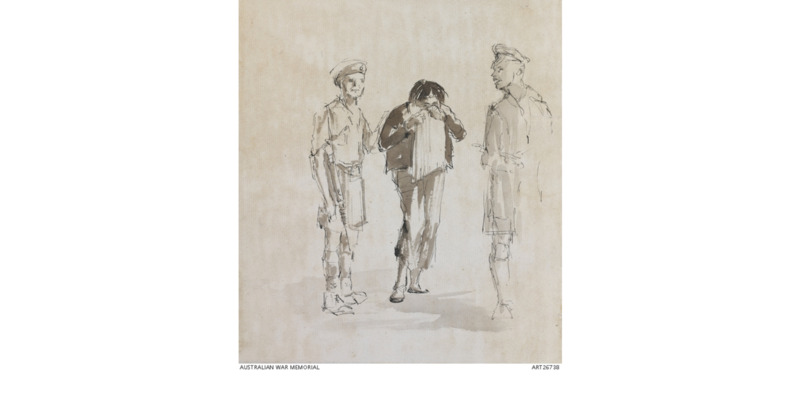Overview: Colonization and Liberation
Koreans are only allowed to retain 1000 yen before being sent back to their homeland. This one has just been relieved of a large sum and is a little upset. A New Zealand soldier gently pushes him on his way.
Korean migration to Japan has a long history, but this movement of people greatly increased during the period of Japan’s colonial rule of Korea. On August 22, 1910, the Empire of Japan formally annexed the Korean Peninsula. The colonization of Korea was another step in Japan’s imperial ambitions which began decades earlier with the First Sino-Japanese War (1894-1895) and the acquisition of Taiwan. Japan’s imperial expansionism would later be articulated as the concept of the “Greater East Asian Co-Prosperity Sphere”.
The reasons for migration to Japan during the colonial period were numerous and complex. However, in the period before the Second World War, the motivations for migration were primarily economic. As is the case with many colonized lands, the imperial Japanese government sought to extract resources from Korea rather than promote overall economic development. Economic strategies such as land acquisition impoverished the Korean countryside, which caused many to look to Japan for greater economic opportunity. Unskilled Korean workers provided a source for cheap labor in expanding Japanese industries, particularly in Osaka and Kobe. In the mid-1920s, there were about 100,000 Koreans who migrated to Japan. This number increased yearly, and by 1938, there were around 800,000 Koreans living in Japan.
The pattern of Korean migration to Japan began to shift from voluntary to involuntary as the Second Sino-Japanese War (1937-1945) expanded. The National Mobilization Law passed in 1938 forcibly conscripted Koreans into the military and the mobilized labor force. As war broke out with the United States in the Pacific, the number of conscripted Koreans dramatically increased. Conscripted Koreans were sent to a myriad of locations on mainland Japan and Japan’s occupied territories in east and southeast Asia to fight on the battlefield and labor in key industries. Thousands of Korean women and girls were coerced into sexual slavery as “comfort women” for the Imperial Japanese Army under the pretense that they would be given employment. Between 1939 and 1945 there were approximately 822,000 Koreans forcibly relocated to Japan. In total, at the end of the Second World War there were around 2.1 million Koreans in Japan.
The surrender of Japan on August 15, 1945 marked the liberation of the Korean people from Japanese rule. However, liberation did not mean that all problems for Koreans were resolved. After every war the broken pieces of a nation must be put back together. Koreans in Japan faced a difficult decision: return to Korea or remain in Japan. If they chose to return, they would be returning to a divided country occupied by two great powers at odds with each other. If they remained, they were choosing to live with an ambiguous legal status in the land of their former colonizers. This exhibit explores the plight of those who were left in the aftermath of a devastating 35 years of suppression and war.
Additional Information:
For more information on the history of the Japanese colonization of Korea, Korean migration to Japan, and the situation of Zainichi Koreans, please visit the website of the History Museum of J-Koreans (在日朝人歴史資料館). I would like to thank the History Museum of J-Koreans for generously allowing me to use images from its collection for this project.

